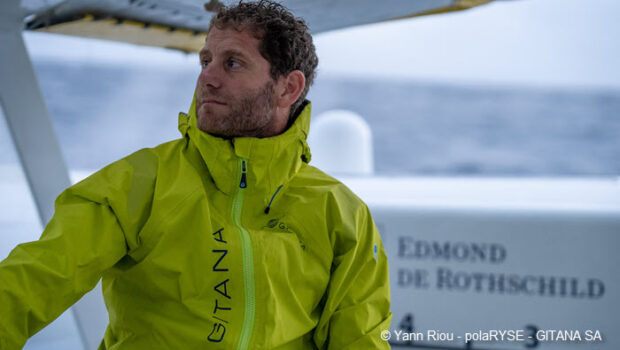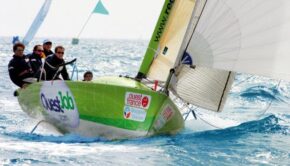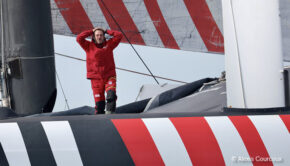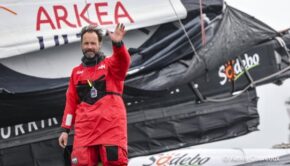Charles Caudrelier: Taking care of the beast
Published on January 30th, 2024
(January 30, 2024; Day 24) – Charles Caudrelier, leading the 2024 Arkea Ultim Challenge-Brest in the South Pacific, discusses life on Maxi Edmond de Rothschild during this solo, non-stop round-the-world race:
We get the impression that you are doing great miles and all the lights are green!
Yes, there are a lot of green lights but there is always a warning above my head. I know that what happened to Tom (Laperche) could happen to me at any moment, that I could break a part and suffer damage.
The boat is tired from a trip half way around the world. On this boat we have never gone this far. But I do feel in good shape, I have good sequences, I get an energy from being first, there is a great thing in not being stressed by a ranking. Yes, this is an ideal situation but this is a mechanical sport, there will be always aspects that cannot be controlled.
Is being able to take care of yourself a luxury?
Well, put it this way, I’m not looking for a record, I’m on the brakes all the time! When I exceed 40 knots, I get yelled at by my routers! I could go four knots faster but it’s a passage around the world, it’s long and hard. I have to pay attention to the phenomenon that is cavitation under the water which can cause micro-cracks on the appendages. And the faster you go the more monstrous the effort.. I must not take any risks and know how to take care of the beast.
You have broken several records, do these numbers interest you?
No, I don’t even look at the times. I don’t want to get into that game. It is dangerous. And after all, I won’t have a crossing of the Pacific, not as good as the one that François made on his record and his return up the Atlantic was really, really great! But we shouldn’t get locked into the wrong objective: it would be stupid to push the boat and break it. I’m not racing against the clock, even if that gets people excited and talking and even if it might make me a little happy in the end….
Listening to you, you seem in pretty good shape.
Yes I am ! Even when Tom pushed me at the start of the race, I managed to find the right balance between sleep and performance. Now I’m more in management, it’s relaxing and sometimes a little boring. But fortune smiles on me, I still have a lucky star for the moment!
We knew we had to fight to get down to the Indian Ocean first because we could “start from the front”. The team also did a very good job because I never had to slow down to make any kind of repairs. I did a little DIY here and there, and I too have had one problem a day. These are small annoyances usually but at 35 knots, they are not easy to resolve!
And when you’re bored, what do you do?
For three or four days that I’ve been sleeping pretty well, cleaning my boat. I tried watching films, I started reading a little on my tablet but I’m having a little trouble. When I relax I start to worry more. My bunk is slightly tilted and that distorts my sensations, I always have the impression of heeling, I have difficulty feeling my boat. And then I had my little problems, I have a sensor on the daggerboard that doesn’t work and I have to adjust it by feel. These things are a bit annoying but that doesn’t stop me from going fast forward!
What moments do you really enjoy?
I’m not a person given to contemplation. Sometimes there are some beautiful lights in the sky but overall it’s gray, there’s fog, wet, damp, mist and I don’t really go outside. What I like more is looking at the charts and data to optimize my trajectory, to choose the right sails. I also really enjoy anticipating, being one step ahead.
What excites me is more the process than the outcome, the result. I really enjoy steering my boat. I know where I have come from on this odyssey, the desire I had to do this exercise, to have been too afraid of it too, and now to do it by myself too. And I enjoy that the boat is well managed and to be here, more than halfway through, is very satisfying in itself.”
Details: https://arkeaultimchallengebrest.com/en
The Arkea Ultim Challenge-Brest is a solo, non-stop round-the-world race for Ultim Class trimarans which have a maximum length of 32 meters and a maximum width of 23 meters.
The solo speed record around the world was set in 2017 by François Gabart (FRA) on the 30m Macif trimaran in a time of 42d 14h 40m 15s for an average speed of 21.08 knots. This yacht has been rebranded and will be raced by Marchand.
Entrants:
• Charles Caudrelier (FRA), Maxi Edmond de Rothschild (2017 Verdier 32/23)
• Thomas Coville (FRA), Sodebo Ultim 3 (2019 VPLP/others 32/23)
• Tom Laperche (FRA), Trimaran SVR-Lazartigue (2021 VPLP 32/23)
• Armel Le Cléac’h (FRA), Maxi Banque Populaire XI (2021 VPLP 32/23)
• Anthony Marchand (FRA), Actual Ultim 3 (2015 VPLP 30/22)
• Éric Péron (FRA), Trimaran Adagio (2014 VPLP 31/21)*
* Only entrant without foiling appendages
Five rules from the Sailing Instructions:
• The start is January 7 from Brest, France. The start line is kept open for 168 hours and the finish line is closed after an elapsed time of 100 days after the start time, that is to say April 16, 2024.
• The skippers can communicate and exchange with their teams on shore, so they have the freedom to get weather information and be routed by their team on shore and get technical help and advice to help with technical problems.
• The solo skippers can stop but there are two distinct operations. A technical stop is unassisted and requires the sailor to drop anchor, take a mooring, or tie up alongside an anchored or moored boat with no external help. There is no time penalty for a technical stop. But for a technical stopover (escale technique) where one or more crew or technical team come on board to help, there is a mandatory 24 hours minimum. This does not apply to the start port of Brest where all means are authorized to reach or leave the port within a radius of 50 miles.
• For the first time in ocean racing, zones where there are known to be a high concentration of whales and sea mammals are determined. Establishing these zones should both protect the marine wildlife and reduce the chance of a collision. These zones are around the Azores, the Canaries, south of South Africa, the Kerguelens, and parts of the Antarctic.
• There are ice exclusion zones to protect the skippers and their boats.









 We’ll keep your information safe.
We’ll keep your information safe.